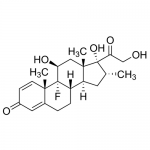| Product Name | Dexamethasone |
| Description |
Glucocorticoid receptor ligand |
| Purity | >98% |
| CAS No. | 50-02-2 |
| Molecular Formula | C22H29FO5 |
| Molecular Weight | 392.47 |
| Field of Use | Not for use in humans. Not for use in diagnostics or therapeutics. For in vitro research use only. |
Properties
| Storage Temperature | -20ºC |
| Shipping Temperature | Shipped Ambient |
| Product Type | Inducer |
| Solubility | Soluble to 100 mM in DMSO |
| Source | Synthetic |
| Appearance | White solid |
| SMILES | C[C@@H]1C[C@H]2[C@@H]3CCC4=CC(=O)C=C[C@@]4([C@]3([C@H](C[C@@]2([C@]1(C(=O)CO)O)C)O)F)C |
| InChI | InChI=1S/C22H29FO5/c1-12-8-16-15-5-4-13-9-14(25)6-7-19(13,2)21(15,23)17(26)10-20(16,3)22(12,28)18(27)11-24/h6-7,9,12,15-17,2 |
| InChIKey | UREBDLICKHMUKA-CXSFZGCWSA-N |
| Safety Phrases |
Classification: Harmful. May be harmful if inhaled, swallowed or absorbed through skin. Safety Phrases: S22 - Do not breathe dust S24/25 - Avoid contact with skin and eyes S36/37/39 - Wear suitable protective clothing, gloves and eye/face protection Risk Phrases: R62 - Possible risk of impaired fertility R68- Possible risk of irreversible effects Hazard Phrases: H315-H317-H319-H334-H335 Precautionary Phrases: P261-P280-P305 + P351 + P338-P342 + P311 |
| Cite This Product | Dexamethasone (StressMarq Biosciences, Canada, Cat # SIH-259) |
Biological Description
| Alternative Names | (11β,16α)-9-Fluoro-11,17,21-trihydroxy-16-methylpregna-1,4-diene-3,20-dione |
| Research Areas | Apoptosis, Cancer |
| PubChem ID | 5743 |
| Scientific Background | Dexamethasone is a potent synthetic glucocorticoid with anti-inflammatory and immunosuppressive properties. In neuroscience, it is used to reduce cerebral edema and inflammation associated with brain tumors, traumatic brain injury, and neurodegenerative conditions. Dexamethasone modulates the hypothalamic-pituitary-adrenal (HPA) axis and suppresses pro-inflammatory cytokine production, which can mitigate neuroinflammation and neuronal damage. Its role in regulating glucocorticoid receptor signaling also makes it relevant in studies of stress-related neuropsychiatric disorders. |
| References |
1. Roila F., and Fatigoni S. (2006) Ann Oncol.17 (Suppl2): ii96-ii100. 2. Hasan E.A., Jessop D.S., Power L.L. Monk P.T. and Kirwan J.R. (2009) Int J Endocrinol. 2009: 391284. |



Reviews
There are no reviews yet.